All 19 entries tagged Coin Of The Month
No other Warwick Blogs use the tag Coin Of The Month on entries | View entries tagged Coin Of The Month at Technorati | There are no images tagged Coin Of The Month on this blog
October 01, 2014
The Power of Words?
 |
| Coin of Augustus with Latin on both sides (RIC 12 358) |
It is a truism that we are increasingly becoming a more visual age and one that plays down the impact of the written word. Everything has to have visual impact to engage and interest the passive spectator. Is PowerPoint the problem or the solution?
But, as often with the classical world, we have been there before. Coins are a good example of communicating a message through visual means and this Coin of the Month series has shown what a huge variety there are. Augustus, in particular, has been studied for his use of iconography in forming and disseminating the image that he wanted throughout the empire (see Zanker’s seminal book The Power of Images in the Age of Augustus).
This coin interested me for its lack of visual stimulus. It seeks to get its message through the written word. It is a denarius, about 18 mm in diameter. At this period, a legionary soldier received 10 asses a day, which amounted to 225 denarii a year.
One side of the coin (the obverse) has text within an oak wreath decorative border, reading as follows: I O M S P Q R S PR S IMP CAE QVOD PER EV R P IN AMP AT Q TRAN S E Expanding the standard abbreviations, adding letters in brackets, we see:
I(ovi) O(ptimo) M(aximo) S P Q R V(ota) S(uscepta) PR(o) S(alute) IMP(eratoris) CAE(saris) QVOD PER EV(m) R(es) P(ublica) IN AMP(liore) AT Q(ue) TRAN(quilliore) S(tatu) E(st)
To Jupiter Greatest and Best, the Senate and the Roman people (give) their vows made for the health of their leader Caesar (i.e. Augustus) because through him the state is in a greater and more peaceful condition.
On the other side is a cippus, a small, low pillar which usually had an inscription on it. On this representation of a cippus there is inscribed:
IMP CAES AVGV COMM CONS S C.
In full this reads:
IMP(erator) CAES(ar) AVGV(stus) COMM(uni) CONS(ensu), S(enatus) C(onsulto)
Caesar Augustus leader with common consent, and with the agreement of the Senate.
In addition, around the inside edge of the coin is written: L. MESCINIVS RVFVS IIIVIR This is the name of the magistrate (Lucius Mescinius Rufus) and his position as a moneyer (triumviri monetales) which helps to date the coin to 16 B.C.E.
How successful was this design? Well, we can’t tell from this one coin, but we do notice that there are other coins from this period with their emphasis on text rather than image, but after this we see very few. We can deduce from this that the innovation was a failure. Why might this be? Estimates of the level of literacy in the Roman world vary. As well as the graffiti of Pompeii, from the opposite ends of the Roman Empire we have writing from the tablets of Vindolanda and the papyri from Oxyrhynchus which suggests that there was a reasonable level of literacy throughout society, but interpretation of the evidence is disputed (Ancient Literacy by W. V. Harris provides a good starting point).
Could this coin have got its message across? Could enough people have read to make it effective? Were the abbreviations too much of a barrier? Was the size of characters too small (the coin is only around 18mm in diameter)? Did coins get worn too quickly? Do people ignore writing on coins (can you remember the words on a £1 coin?) Was it a brave attempt at a new, more sophisticated form of communication that did not work well enough? Perhaps it is true that a picture is worth a thousand words.

Clive Letchford is a Teaching Fellow in the department, teaching Latin and Greek to those who have not had the opportunity to learn these wonderful languages before arriving at Warwick.
(Image © The Trustees of the British Museum)
September 02, 2014
Archimedes' Theorem of the Sphere & Cylinder: Martin Hairer's Fields Medal & Immortality of Science
Numismatics does not only include the study of coins but also a range of coin-like objects, such as medals, tokens and other related items. This month's 'coin of the month' is actually a medal: the Fields medal, displayed on the University's main home page, awarded by the International Mathematical Union to Martin Hairer, professor in mathematics at Warwick University, for his outstanding achievements in stochastic partial differential equations (SPDEs). This recognition is of highest international renown and the University can be proud of such a scholar.
As a classicist I am light-years away from understanding SPDEs and adequately appreciating his dazzling theory of regularity structures. Yet, there is a quote from Hairer which is, I believe, appealing to classicists: 'One advantage of mathematics is the immortality. Theorems that were proven 2,000 years ago are still true...' This is food for thought within our own disciplines of Classics and Ancient History, including numismatics. Would we claim immortality for our field of research as well? My answer is 'yes', and the medal itself provides an excellent example to underpin this affirmation.
The obverse depicts Archimedes (in a post-World War I artistic style) and the Greek legend ΑΡΧΙΜΕΔΟΥΣ (‘of Archimedes’) and the Latin legend TRANSIRE SVVM PECTVS MVNDOQVE POTIRI (‘Exceed above oneself and grasp the world’). The reverse shows a tablet (a tabula ansata) with the Latin inscription CONGREGATI / EX TOTO ORBE / MATHEMATICI / OB SCRIPTA INSIGNIA / TRIBVERE (‘Gathered from the entire world, Mathematicians have awarded (this medal) for outstanding writing’). The tablet is displayed on a laurel branch, and the branch is placed upon a background with Archimedes' theorem of the sphere and cylinder, a line drawing of a sphere inscribed in a cylinder. Archimedes had proven that both the volume and the surface area of the sphere were two-thirds that of the cylinder.
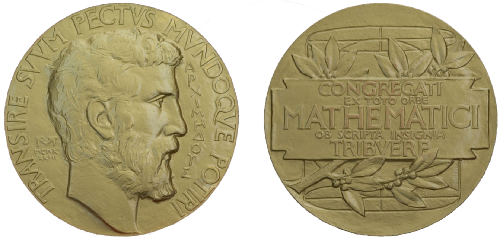
The fields medal awarded to Martin Hairer by the International Mathematical Union on 13 August 2014. The medal is in gold, and bears the monogram RTM, the signature of the artist Robert Tait McKenzie (1867-1938). The date is MCMXXXIII.
The medal has an impressive concentration of references to antiquity. Archimedes (c. 287-212 BC) was active in the Hellenistic period at the court of King Hieron II in Syracuse (275-215 BC) and is considered the greatest ancient mathematician. He died during the sack of Syracuse by the Romans in 212 BC, sadly killed by a Roman soldier according to Plutarch (Marcellus 19.4-5) when he was working out a problem involving circles. Plutarch (Marcellus 17.7) relates also that his tomb was adorned with his theorem of the sphere and cylinder and that, proud of his achievement, it was Archimedes himself who requested the theorem adorn his funerary monument.
With the Fields medal the community of modern-day mathematicians refers to one of their most famous forerunners. They define themselves in the present through the past, and by doing so they build up a foundation for the future. They are, by the way, not the first to go back to Archimedes or his tomb monument. The philosopher and statesman Cicero (106-43 BC) had already gone in search of the tomb and its theorem. He discovered it outside Agrigentum, overgrown by thorn bushes (Tusculum 5.23.64-65).
The laurel branch on the reverse, at the root of the word 'laureate', and the shape of the tablet are further references to antiquity. The laurel was awarded to winners of the Pythic games, and later on laurels in the form of wreaths were awarded to Roman victors in triumph, to poets, and to Christian martyrs.
Referring back to forerunners and their achievements is taking an example from earlier scholarship as a way of legitimatizing present and future research activities. It is also an act of humility by relativizing a single achievement. This is also expressed by the fact that the laureate's name is missing. According to the instructions of John Charles Fields, who established the award, the medal should not bear the name of an individual nor of a nation, and the legend had to be in Latin or ancient Greek. Moreover the medal was not only to be awarded for past achievement, but also to encourage future research. (As a matter of fact, the name of the recipient is engraved on the medal’s edge.)
To inscribe the present into the unlimited time-span between past and future means breaking up limits. This principle is as immortal as Archimedes’ theorem, and it makes ancient history, as well as history more generally, an immortal science. Immortality on the other hand stands in cruel contrast to the reality of human life. Immortality in science therefore responds to the human hope to transgress the limitations of being a human being and maybe to hope for eternal life.
This is expressed by the inscription on the obverse of the medal which is a quote from Marcus Manilius, a poet and astronomer of the first century AD: TRANSIRE SVVM PECTVS MVNDOQVE POTIRI—‘Go beyond oneself and grasp the world’ (Astronomica 4.392). This comes from a longer passage on the signs of the zodiac where the author advocates the arduous study of astronomic science as a way of seeking God: ‘Quod quaeris, deus est’ (Astronomica 4.390).
The desire to create a tomb monument ascribed to Archimedes is likewise connected with mortality and immortality. And the medal itself is a small monument. It is not issued, like coins, in big masses, but struck for the laureates only. It is not spent like money, but carefully kept aside or displayed. It is not overgrown by bushes like a stone monument, but genteelly adorns by the recipient.
 This month’s coin was chosen by Suzanne Frey-Kupper, Associate Professor of Numismatics and Classical Archaeology at the Department of Classics and Ancient History at the University of Warwick. She works on Greek, Punic, and Roman coinage from the Western Mediterranean and the North-Western provinces. She has published the coin finds from many major archaeological sites, in Italy and Sicily, Malta, Cossyra, Carthage and North of the Alps. With N.K. Rutter and J. Morcom she is currently preparing the volume Sicily and the Adjacent Islands of Historia Numorum.
This month’s coin was chosen by Suzanne Frey-Kupper, Associate Professor of Numismatics and Classical Archaeology at the Department of Classics and Ancient History at the University of Warwick. She works on Greek, Punic, and Roman coinage from the Western Mediterranean and the North-Western provinces. She has published the coin finds from many major archaeological sites, in Italy and Sicily, Malta, Cossyra, Carthage and North of the Alps. With N.K. Rutter and J. Morcom she is currently preparing the volume Sicily and the Adjacent Islands of Historia Numorum.
This summer she was a visiting scholar of the Summer Seminar at the American Numismatic Society (ANS) in New York where she was awarded a medal (shown below) by the New York Numismatic Club with a similar reverse to the medal described above. On its obverse is Henry Grunthal (1905-2001). Born in Cologne (Germany), son of numismatist and medal publisher Hugo Grunthal, Henry Grunthal emigrated to the United States in 1938, joined the ANS in 1953 and advanced to the position of curator of European and modern coins. His work focused on Carolingian coinage and on the coinage of Peru. He studied archaeology and art history Berlin, Jena and in Paris, and numismatics under Kurt Regling (1876-1935) in Berlin and Behrendt Pick (1861-1940) in Gotha. The latter was a student of Theodor Mommsen (1817-1903) and later worked with Regling on Mommsen’s ‘Griechisches Münzwerk’ (Die antiken Münzen Nord-Griechenlands. Dacien und Moesien, 2 vols, Berlin 1898 and 1910). Both Pick and Mommsen were, for a short period, professors in Zurich, where Suzanne Frey-Kupper studied Classical Archaeology and lectured for a few years before joining Warwick in 2011.

August 01, 2014
The Emperor on a chain: Fashionable coins and questions of personal taste
 |
| Coin of Constantine used as a pendant |
This coin of Constantine dates from AD 330-331. It is typical of its type. The obverse displays an image of Constantine whilst the reverse praises the might of the Roman army; two soldiers holding spears flank military standards with the legend ‘GLORIA EXERCITVS’. The modern transformation of this particular coin into a piece of jewellery is not without its ancient precedent, and this has prompted me to investigate the afterlife of coinage in the Roman world.
It is widely accepted that coins are not simply important for their monetary value. To historians studying numismatics their imagery and legends provide evidence for things as diverse as architectural styles to hairstyles. Similarly, at the time of minting, coins held a value which extended further than what they could buy. The way that coins were used outside of the context of financial transactions can teach us valuable lessons about Roman society.
In Petronius’ Satyricon, the character Trimalchio is described as playing a board game with gold and silver denarii instead of the standard black and white counters. Trimalchio is more of a caricature than a character, so we should take scenes like this with a pinch of salt, but the author is here making a point about how the attitude of an individual towards coinage projects a social statement about their personal wealth. Trimalchio’s self-display tells his guests that he can, quite frankly, afford to play with his money. This can be extended to help us to understand why incorporating coinage into jewellery was a way of displaying your wealth and social status.
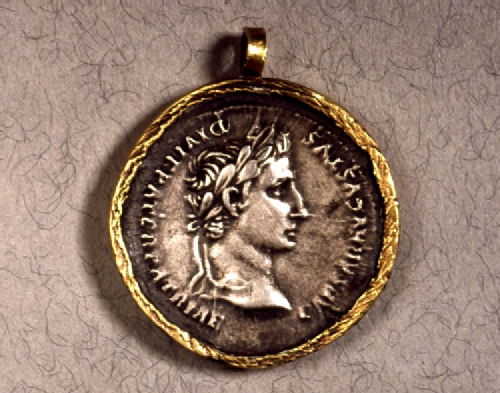 |
|
Coin of Augustus used as a pendant © The Trustees of the British Museum |
But self-display was not the sole reason why an individual would choose to transform coins into jewellery. Nor can it simply be explained as a fashion, since fashions change and our evidence for coin pendants spans hundreds of years. A study of the iconography of the coins chosen for this purpose suggests that not just any coin would do. Generally our examples are drilled to allow a chain to pass through, or else a loop attached, and the location of this tells us which way the coin was intended to hang. In most cases the coin was orientated to display the obverse, most tellingly, the image of the emperor. For example, the coin pictured here is orientated to display the diademed profile of Augustus. This coin was minted in 2 BC and its use here celebrates the reign of Augustus. Thus one could argue that coin pendants projected a political as well as social message. The modern day transformation of the ‘Gloria Exercitvs’ coin follows this ancient precedent, but this time the choice was motivated by aesthetic value rather than a desire to make a political statement of allegiance to the emperor.
It is debatable whether the Roman jeweller was motivated by the aesthetic, political or social potential of coinage when they set about incorporating coins into jewellery. Clearly, these artefacts pose questions about the nature of Roman society and the nature of its value system; and since coin pendants remain popular today we could trick ourselves into believing that we are not so different from the Romans after all.
 This month's coin was chosen by Eve Bayram. Eve graduated from Warwick in 2014 with a degree in Classical Civilisation. While at Warwick Eve focused on the study of Latin literature, and her disseration was entitled 'Self-presentation in the Latin epistolary genre: Cicero, Seneca, Petrarch.' She is currently interning in the dictionaries department at Oxford University Press.
This month's coin was chosen by Eve Bayram. Eve graduated from Warwick in 2014 with a degree in Classical Civilisation. While at Warwick Eve focused on the study of Latin literature, and her disseration was entitled 'Self-presentation in the Latin epistolary genre: Cicero, Seneca, Petrarch.' She is currently interning in the dictionaries department at Oxford University Press.
July 01, 2014
Coin of the Month: Two Coins Depicting Germania
 |
| Gold coin of Domitian showing Germania |
In 83 AD the Emperor Domitian (81-96 AD) conducted a campaign against the Germanic tribe of the Chatti, the first emperor to campaign in person since Claudius’ expedition to Britain in 43 AD. Literary tradition is divided over the success of campaign; Iulius Frontinus commended Domitian’s strategy and handling of troops, but other sources suggested that the Chatti were not subdued and continued to pose a threat, even if defences of the frontier were improved. In any case, Domitian proclaimed a victory and had this magnificent aureus struck in Rome around 84 AD. The obverse shows a laureate head of Domitian facing left, wearing an aegis. The legend overhead reads IMP(erator) CAES(ar) DIVI VESP(asiani) F(ilii) DOMITIAN(us) AUG(ustus): ‘Emperor Caesar Domitian Augustus, son of the divine Vespasian’. The reverse depicts a humbled and sorrowful semi-naked female figure sitting on a beautifully embossed shield. A broken spear can be seen underneath. The inscription overhead proclaims Domitian’s title of victor of the Germans: GERMANICUS CO(n)S(ul) X.
 |
|
Gold coin of Trajan showing Germania © The Trustees of the British Museum |
The depiction of Germania in the second coin is very different. This coin is an aureus struck in Rome in 98-99 AD. The obverse displays the laureate head of Trajan (98-117 AD) facing right, with the legend IMP(erator) CAES(ar) NERVA TRAIAN(us) AUG(ustus) GERM(anicus): ‘Emperor Caesar Nerva Traianus Augustus Germanicus’. The reverse bears the words PONT(ifex) MAX(imus) TR(ibunus) POT(estas) CO(n)S(ul) II: ‘chief priest, holder of tribunician power, consul for the second time’. It depicts Germania seated on a pile of shields, resting her left arm on a hexagonal shield and holding an olive branch in the right hand. The pile of shields and the olive branch suggest the end of confrontation. At the same time, the semi-naked proud figure of Germania reminds the viewer of Tacitus’ descriptions of hostile, free, ‘barbaric’ Germanic tribes. So instead of depicting a conquered Germania like in Domitian’s coin, Trajan’s aureus presents Germania as a barbarian nation making a pact with Rome under the paternal gaze of the emperor. In this way the second coin also advertised Trajan’s successful tenure as governor of Germania before he succeeded his adoptive father Nerva in 98 AD.
 This month’s coin was chosen by Desiree Arbo, a second year PhD student. Desiree’s research focuses on the reception of classical texts in 18th-19th century Spanish America. She is currently exploring how Jesuit missionaries used classical themes and texts to depict the Guarani Indians of Paraguay.
This month’s coin was chosen by Desiree Arbo, a second year PhD student. Desiree’s research focuses on the reception of classical texts in 18th-19th century Spanish America. She is currently exploring how Jesuit missionaries used classical themes and texts to depict the Guarani Indians of Paraguay.
(Coin of Domitian above reproduced courtesy of Numismatica Ars Classica NAC AG (Auction 67, lot 139)
June 01, 2014
Coin of the Month: Augustus, and How to Make Road Repairs Exciting
 |
| Denarius of Augustus, © The Trustees of the British Museum |
This month's coin of the month is a silver denarius struck in Rome in 16 BC commemorating Augustus' improvement of the roads in Italy. These road repairs were evidently an important part of Augustus' building programme. In fact, he takes pains to mention them in his Res Gestae (20.5): "In my seventh consulship I constructed the Flaminian Way from Rome to Arminum and all the bridges on it except for two that were not in need of repair" (trans. Cooley). The completion of these works were marked by this coin and by others struck in mints in Spain.
The iconography of this coin is highly unusual, reflective of the experimental atmosphere that prevailed under Augustus as an imperial language of numismatic imagery was formulated. The odd nature of the imagery on this piece, however, may also have been due to the difficulties in visualising this particular act of imperial munificence. After all, how do you design a coin which communicates road repairs?? And in an eye catching and exciting way?? The designers of this coin chose to focus on objects which alluded to Augustus' activities without actually having to show a road. The obverse of the coin (left) shows a statue of Augustus on a horse before the walls of the city, likely an allusion to the beginning of the Flaminian Way. The reverse shows a column erected by the Senate for Augustus in Rome to thank him for his repairs. The column reads:S P Q R IMP CAE QVOD V(iae) M(unitae) S(unt) EX EA P(ecunia) Q(u)IS AD A(erarium) DE(dit) (The senate and people of Rome to Imperator Caesar because the roads have been paved out of the money which he gave to the treasury).
The mints in Spain that struck similar types (see examples here, and here) echo the same phrase (QVOD VIAE MUNITAE SVNT, because the roads have been paved), suggesting that these coins are co-ordinated in some way, or responding to the same edict. The Spanish coins also highlight statues of Augustus that graced the roads and bridges, rather than representing the roads themselves. Statues of Augustus in connection with the roads are mentioned by Dio (53.22.1), but what is most interesting about these issues is that the statues are shown all out of proportion to the bridges and the city wall (they are shown as larger than life). As Zanker points out, this is because coins reflect how the Romans viewed monuments, rather than provide us with a 'photo' or realistic representation. In the early imperial period, statues are often shown as larger than the buildings or monuments themselves on coins, a reflection of the fact that Romans were most interested in the political message of a particular building programme. Later on in the Empire, the statues become smaller and the buildings themselves dominate coin types, reflecting a change in the practice of Roman viewing.
 This month's coin was chosen by Clare Rowan, a Research Fellow in Numismatics. Amongst other projects she is currently working on a Cambridge University Press/American Numismatic Society Handbook to Coinage of the Ancient World, covering the period from 49 BC until AD 14.
This month's coin was chosen by Clare Rowan, a Research Fellow in Numismatics. Amongst other projects she is currently working on a Cambridge University Press/American Numismatic Society Handbook to Coinage of the Ancient World, covering the period from 49 BC until AD 14.
May 01, 2014
Coin of the Month: A Denarius of Augustus, Presenting a Dynasty
 |
| Denarius of Augustus |
This denarius of Augustus dates from 2-4 BC. The obverse features a laureate head of Augustus with the legend ‘CAESAR AVGVSTVS DIVI F PATER PATER PATRIAE’. The reverse depicts his two grandsons Gaius and Lucius stood facing each other, hands resting on a shield and spear, with a simpulum and lituus above. The legend around the edge reads ‘AVGVSTI F COS DESIG PRINC IVVENT’ and ‘C L CAESARES’ is written horizontally underneath the figures.
The coin is a useful example of the control that Augustus exercised over his personal image. The bust appears as that of a young man, however the emperor would have been in his 60s at this point. It is also illustrative of the problem of succession that faced an ageing Augustus. Having no sons of his own, the emperor had adopted his two grandsons and this coin is a clear message that they are the heirs to his title and powers. The beginning of their public careers is alluded to by the presentation of the title of “Leaders of the Youth”, as well as the appearance of both military and priestly images around them. Gaius’ and Lucius’ positions within the family are also emphasised by the fact that the two are explicitly called the sons of Augustus. Also, the prominent way in which ‘Caesares’ is placed upon the coin has clearly dynastic overtones, especially given that it was the name that Augustus himself took following his own “adoption” by Julius Caesar, which launched his political career. This theme is further continued on the obverse, where Augustus presents the title ‘Divi Filius’ (“Son of a God”) alongside that of ‘Pater Patriae’ (“Father of the Country”). By presenting himself as both son and father, Augustus is drawing the parallel to his own adoption as well as that of his grandsons and it is made clear that an imperial dynasty, with the successive handing down of powers, has been founded.
This particular denarius is contained within the South-Warwickshire Hoard of Roman denarii, which was discovered in 2008 by a local metal-detectorist. The hoard is comprised of 1153 silver denarii, with dates ranging from 190 BC to AD 64. It is one of the largest coin hoards from the Roman world and is made even more special by the fact that the pot in which the coins were buried has also survived. The South-Warwickshire Hoard was acquired by Warwickshire Museum, catalogued by Stanley Ireland and it is currently on display at the Market Hall Museum in Warwick.
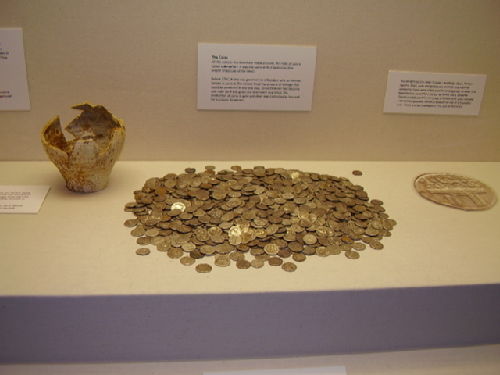 |
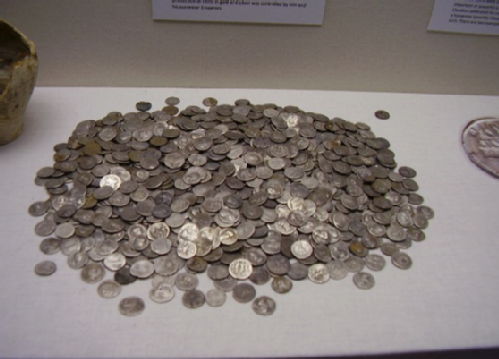 |
The South Warwickshire Hoard in the Warwickshire Museum
This month's coin was chosen by Abigael Flack, a museum assistant at the Warwickshire museum. Abigael is interested in the presentation and reception of the Roman imperial regime, particularly in literature. Her MA thesis examined this theme in the biographies of Suetonius.
(Images courtesy of Sara Wear and Heritage & Culture Warwickshire.)
April 01, 2014
The "King of the Britons" Coin
 |
| Coin of Cunobelinus |
Before the invasion of Britain in AD 43 by the Roman Emperor Claudius, we have very little information on the earlier rulers of Britain. Classical accounts speak of only a few British chieftains, so our main source of evidence as to who these rulers were comes from the coins minted by the British kings themselves. Therefore this month’s coin belongs to Cunobelinus, a tribal leader active in South-western England from around AD 30.
This British coin is quite similar to its Roman counterparts. It uses a depiction of a head on the obverse similar to that of the Roman Emperors on their coins, and on the reverse a centaur is depicted. The centaur is a Greek mythological creature, and not part, as far as we are aware, of the pre-Roman British mythology. The use of Greek and Roman imagery was fairly common in this period, but it represents a new design of British coins. Horses had been very prevalent on coins, inspired by Macedonian coinage, but designed in such a local, British way, that they look very different from the depictions of horses in the Greek and Roman worlds. The designs on this coin indicate increased awareness of Roman styles, representing a stronger connection to the Roman world. As a bronze coin, this coin is unlikely to have been used for trade with the Romans, who traded in silver for the most part, although it is possible the ideas expressed on the coins were communicated to the Romans through a different medium. Thus the imagery is more likely to have targeted Cunobelinus’ British subjects. Wine amphorae from Rome have been found in elite burials in this period, indicating there was increased contact and trade with the Romans, and that the British elite were starting to adopt Roman customs. A ruler who was also interested in Roman designs would thus be more favoured as a leader. Thus even before the Roman invasion, the British were already adopting Roman customs and art styles. It was not “forced upon them” by the invading Romans.
Nonetheless, despite the increased interest in Roman culture, the centaur is a strange image to use, seen rarely on other coins even in the Greek and Roman world. The legend on the reverse reads “TAS…ONI…” (TAS[CI]OVA[NIF]), a reference to Tasciovanus, Cunobelinus’ father. Thus perhaps the centaur is being directly associated with Cunobelinus’ father. In Greek and Roman mythology, the centaur is often representative of drunkenness and barbarianism, not an ideal fatherly representation, so perhaps the British saw the centaur in a different way. The British had great veneration for horses, often depicting horses on their coins, so they were clearly a symbol of significance. They were probably representative of power, as horses are strong animals, and they also communicated wealth, as to own a horse costs a lot of money. Therefore a centaur, as a hybrid of horse and man, in British eyes may have represented a man being combined with this powerful creature. In this way, perhaps Tasciovanus is being displayed as the centaur, as a man with the great power and wealth associated with a horse. In this way, Cunobelinus depicts his ancestry as great, which would have made him popular with his people.
Some scholars have seen the Roman head on the obverse as representing the Roman Emperor, and thus the coin is designed to praise the Roman leadership. However, with the legend of “Cunobelin…” nearby, it seems the head is actually representative of Cunobelinus himself. Why he chose to do this can be seen in the Roman biographer Suetonius’ account. He states that the Emperor Caligula received the surrender of Adminius, who Suetonius describes as “Cynobellini Britannorum regis filio”: “the son of the king of the Britons, Cunobelinus” (Suetonius Caligula 44.2). Suetonius’ description seems to indicate that Cunobelinus ruled all the people in Britain, when in reality it was made up of many different tribes, each controlled by their own king. Either Suetonius has got his facts wrong, or perhaps he is buying in to Cunobelinus’ propaganda. There is no British equivalent of an Emperor, a man in charge of a huge amount of lands and tribes, so perhaps Cunobelinus is taking the imagery of a Roman Emperor in order to give the impression that he is even more powerful than just an average tribal chieftain, making him appear the most powerful man in Britain. In fairness, this may not be too far from the truth, as some scholars believe that during his reign, Cunobelinus was acquiring new territory in the South of Britain, so he may have needed to prove he was worthy of this large portion of land. While Cunobelinus probably was nowhere near the sole ruler of Britain, his representation of himself as an Emperor could well have convinced some Romans, as seen in Suetonius’ account, that he was, or at least a major player in British politics. This would help immensely to encourage trade, as Roman traders may have been deceived into seeing Cunobelinus as the most powerful, and thus the richest man in Britain, and thus the best person to go to with their desirable wares.
 This month's coin is chosen by David Swan. David is currently an undergraduate student of Classical Archaeology and Ancient History at the University of Warwick. His interests include numismatics, and prehistoric Britain.
This month's coin is chosen by David Swan. David is currently an undergraduate student of Classical Archaeology and Ancient History at the University of Warwick. His interests include numismatics, and prehistoric Britain.
(Coin image above reproduced courtesy of Classical Numismatic Group Inc., (Mail bid Sale 66, lot 46) (www.cngcoins.com))
March 01, 2014
A gold octadrachm of the Ptolemaic Dynasty
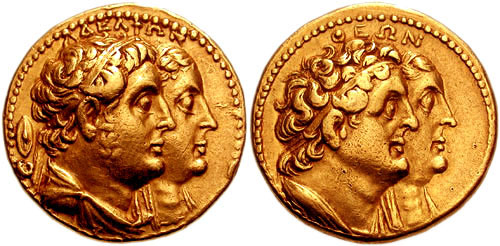 |
| Octadrachm of the Ptolemaic Dynasty |
This gold octodrachm was struck at the mint in Alexandria in Egypt, probably under Ptolemy II (this series was likely introduced under Ptolemy II, and was struck until Ptolemy V). The obverse jugate portrait busts are that of Ptolemy II and his sister-wife Arsinoë II (philadelphoi). Both heads are diademed, with that of Arsinoë probably veiled (it is a little difficult to tell). Both busts have a chlamys. The legend within an off-centre dotted border reads ΑΔΕΛΦΩΝ (adelphon), a genitive plural meaning ‘of the siblings’. The reverse depicts the jugate busts of Ptolemy I and Arsinoë I (Soteroi), the parents and predecessors of the obverse subjects. Again, both are diademed and are wearing a chlamys. The legend within the dotted border reads ΘΕΩΝ (theon) meaning ‘of the gods’. This coin presents us with two generations of the Ptolemaic dynasty of Egypt represented on one coin. In light of Ptolemaic iconography up to this issue, this octodrachm is unique, contributing to the on-going iconographic development of Ptolemaic image and ideology.
It was not the everyday bronzes which carried the vanguard iconography of royal ideology, as Ptolemaic bronzes are markedly more conservative and conventional in their iconography, limited to a head of Zeus on the obverse and an eagle on the reverse. Nor are silver types particularly innovative, as they tended also to be similarly iconographically consistent. The more radical and innovative ideological presentations seem reserved, at least early in the Ptolemaic dynasty, for gold issues. From this octodrachm we recognise the preoccupation with retroactive referencing to previous sovereigns and predecessors. But there is also a horizontal reference, in the inclusion of wife and sister, placed behind as they are, but tellingly also parallel to the king. Their co-ruling is suggested, as is the influence of the Ptolemaic queen within the royal court. Familial undertones also come through, with insinuations of loyalty, and secure dynastic succession derived from strong familial bonds. In relation to the ruling king, this reinforces the image of legitimacy in his kingship. The near-identical jugate portraits possess a regal bearing; the duplication betrays aspirations of wanting to be seen as an established royal house. As subjective in interpretation this type may be, they are the result of generations of (generally) dynastic development and (particularly) developments in coin iconography. This process was continued little by little, in experimenting with new ideas of imagery, and ways of presenting and announcing those images, one attribute at a time.
This month's coin was chosen by Sean Gallagher. Sean Gallagher is currently an undergraduate student of Classical Archaeology and Ancient History at the University of Warwick. His interests include religious and cult continuity, numismatics and New Testament Greek.
(Coin image above reprpduced courtesy of Classical Numismatic Group Inc., www.cngcoins.com)
February 01, 2014
A coin of the dog star from Karthaea, Keos
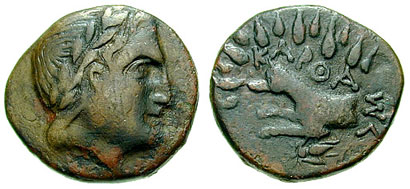 |
| Coin of Karthaea, Keos, showing the Dog Star |
This coin of the month comes from Karthaea on the island of Keos in the Cyclades and dates to the 3rd century BC. On the obverse the head of Apollo is shown crowned with a laurel wreath. On the reverse a dog is depicted with rays emanating from its head, representing the Dog Star. The legend reads ΚΑΡΘΑΣΑ. The images depicted are associated with an ancient local cult that sacrificed to Zeus and to the Dog Star so that the Etesian winds might blow, bring cooler weather, and ward off disease.
The Dog Star is the brightest star in the night sky when it rises in late summer and it is traditionally associated with the Dog Days, when there is hot weather. Because of its brightness and its bluish hue, the star was believed to produce “emanations” which could bring on deadly epidemic diseases. Indeed, in ancient Greek thought as far back as Hesiod and Homer, the Dog Star was believed to have brought on diseases associated with the over-heating and drying of the body, such as fevers.
The cult on Keos is fascinating as it shows the inhabitants trying to guard against the effects of the Dog Star. Both Apollonius Rhodius and Callimachus describe the practices and rituals involved, as well as the mythology behind this cult. The story goes that the Dog Star was burning the Cyclades with its heat and producing much pestilence on the islands. The people of Keos prayed to the rural god Aristaios, the son of Apollo and Cyrene, who was taught both medicine and divination by the Centaur Chiron. Aristaios came to Keos and built a large altar to Zeus Ikmaios. He then offered sacrifices to Zeus and to the Dog Star from the mountaintops and Zeus, in response, sent the Etesian winds to cool the land for forty days.
Aristaios ordered the islanders to perform this rite every year so as to appease the violent rising of the Dog Star and to pray to Zeus for the Etesian winds. The scholia of the text describes how the islanders watched for the rising of the Dog Star every year from the mountaintops clad in their armour and with weapons in hand. Also, by observing the appearance of the star the inhabitants would try to determine whether the island would suffer from epidemics or not. The scholia states that if the star appeared clear and bright, the islanders would experience a healthy year, but if it appeared misty and dull, disease would spread across the island. This practice, in which stars were read in order to predict the weather and disease continued into later medical thought and can be found in medical texts such as The Hippocratic Corpus.
 This coin was chosen by Rebecca Taylor. Becky is a 3rd year PhD student studying the effects of the natural environment on the human body in the thought of the 5th and 4th Centuries BC.
This coin was chosen by Rebecca Taylor. Becky is a 3rd year PhD student studying the effects of the natural environment on the human body in the thought of the 5th and 4th Centuries BC.
(Coin image above reproduced courtesy of Classical Numismatic Group Inc., Mail bid Sale 60, lot 589 (www.cngcoins.com)
January 01, 2014
Medal of Cosimo de' Medici, Pater Patriae
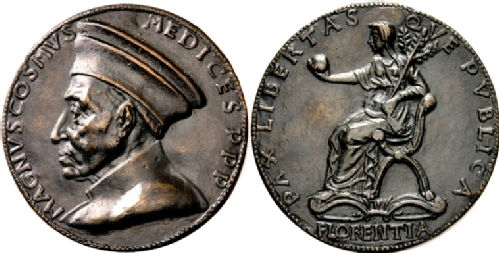 |
| Medallion of Cosimo I de'Medici as Pater Patriae |
This bronze medal is the earliest example of a product created by the Florentine school. It celebrates Cosimo I de’Medici (1389-1464). He was the head of the de’Medici family, a family of bankers who were the de facto rulers of Florence during most of the Italian Renaissance. Cosimo I was granted the title Pater Patriae by the Florentine Signoria after his death on 1 August 1464. According to some scholars, the title was actually conferred on him through a decree dated to 20th August 1464, while others argue that he was granted this title through a decree dated to March 16th 1465. However, the medal was certainly not produced after 1469, the year of Piero il Gottoso’s death; the latter was the dedicatee of an Aristotelian manuscript —Florence, Biblioteca Medicea Laurenziana, Ms Plut. 84, I, c. 3— which was produced by Francesco di Antonio del Chierico on behalf of Piero di Lorenzo de’Medici. Indeed, the effigy of the medal was copied in an illumination of the manuscript by Francesco del Chierico.
The obverse of the medal presents the bust of Cosimo I in profile, facing left. He is wearing a flat beret, which was proper for persons of high rank, and a buttoned cloak. The circular legend, in Roman capital letters, reads as follows: MAGNVS COSMVS MEDICES P(RIMVS) P(ATER) P(ATRIAE).
The reverse shows a female figure, seated on a throne, which is the allegory of Florence: indeed the exergue reads FLORENTIA. The figure is inspired by Graeco-Roman coins depicting Concordia. She is wearing a peplos and is veiled, likely as a sign of mourning for Cosimo. In her left hand she holds an olive branch ending in three shoots. In the other hand, stretching forward, she grasps a globe, which might recall the Medici family emblem: a set of red balls on a gold shield. The folding seat of Florentia is placed upon a yoke on the ground. The circular legend of the reverse reads PAX LIBERTASQVE PVBLICA.
A golden exemplar of the medal is shown in a relief in gilded stucco inset into the Portrait of a Young Man with a Medal of Cosimo il Vecchio by Botticelli, now preserved in the Uffizi. The likeness of Cosimo de’ Medici depicted in the medal also inspired numerous posthumous portraits of him, including that by Jacopo Pontormo in the Uffizi.
Many different artists have been proposed for the medal’s creator: Niccolò di Forzore Spinelli, Donatello, Michelozzo, Cristoforo di Geremia, and Bertoldo di Giovanni. Nevertheless, the controversial question concerning the author’s identification basically remains a mystery. According to a fascinating interpretation, the young man depicted in the portrait by Botticelli might be the designer of the medal, Antonio Botticelli, the painter’s brother. Antonio Botticelli had indeed recast and gilded medals, working in the court of the Medici family.
The whole idea of a ʽportraitʼ on coins, as shown here, as well as the title pater patriae, was inspired by the rediscovery of Roman coins in the Renaissance, as medieval coinage did not have portraits. Ancient coins, especially the Roman imperial sestertii, were the subject of interest and intense study among Renaissance scholars from the early fifteenth century onwards. These coins were admired by humanists for their large size, their high relief, and the use of bronze, which was rarely used for medieval coinage. As a result of a process that started in the thirteenth century, various minting authorities introduced significant innovations in the appearance of the circulating coinage. Additionally, the influence of some aspects of ancient coinage resulted in the creation of a new artistic medium in the medal.
A substantial difference between Roman imperial coins and their medieval counterparts was, first of all, the profile portrait bust of a ruler on the obverse, and secondly the representation of classical deities, contemporary scenes or monuments on the reverse. Coins of the later Middle Ages did not have the reverse exergue line, often with letters beneath it, and the legends were less detailed and written in the Gothic letters derived from medieval book hands rather than the Roman capital letters used on imperial coins.
 This month’s coin was chosen by Rocco Di Dio, a third-year PhD student. His research project focusses on three Greek manuscripts produced by the Renaissance scholar Marsilio Ficino (1433-1499), who was largely responsible for the revival of Platonism in western Europe. Rocco’s main interests lie in Palaeography, Codicology, Byzantine Studies, Platonic philosophy and the Renaissance reception of Platonism.
This month’s coin was chosen by Rocco Di Dio, a third-year PhD student. His research project focusses on three Greek manuscripts produced by the Renaissance scholar Marsilio Ficino (1433-1499), who was largely responsible for the revival of Platonism in western Europe. Rocco’s main interests lie in Palaeography, Codicology, Byzantine Studies, Platonic philosophy and the Renaissance reception of Platonism.
(Image above reproduced courtesy of Dr. Busso Peus Nachfolger, Auction 400, lot 1332)
 Clare Rowan
Clare Rowan

 Please wait - comments are loading
Please wait - comments are loading

 Loading…
Loading…

